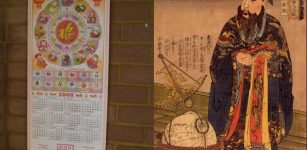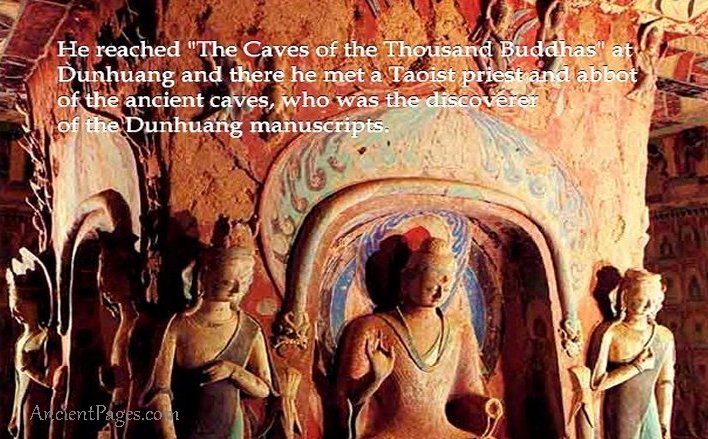Golden ‘Etruscan’ Orphic Book – Six Golden Pages Of The Oldest Book In History Of Mankind
A. Sutherland - AncientPages.com - More than sixty years ago, a unique discovery was accidentally made in the Valley of Struma River, the river in western Bulgaria, during road construction works.
A small book was found in an old tomb covered with frescoes. It is the world's oldest book in the history of humankind, made of gold and dated to 600 BC.
The illustrated six golden pages are made of 23.82-karat gold (measuring 5 centimeters in length and 4.5 centimeters in width) and fastened together with gold rings. The pages are covered with text and decorated with images of warriors, a horseman, a Siren, and a lyre.
Two independent experts from Bulgaria and England confirmed the book's authenticity.
According to researchers from the National Museum of History in Sofia, Bulgaria, the six sheets are believed to be the oldest comprehensive work involving multiple pages. The expert said, "there are about 30 similar pages known in the world, but they are not linked together in a book".
This precious work was written in the Etruscan language that belonged to the Etruscans, one of Europe's most mysterious ancient peoples, who are believed to have migrated from Lydia in modern western Turkey, settling in northern and central Italy nearly 3,000 years ago.
The Ancient Thracian Golden Orphism book, discovered in 1955, in the Struma River valley, in Bulgaria. It is exposed in the National history museum in Sofia. Image credit: Ivorrusev - CC BY-SA 4.0
They were wiped out by the conquering Romans in the fourth century BC, leaving few written records.
The real problem with deciphering Etruscan language lies in understanding the exact meanings of the words and grammatical forms. The language cannot be related to any other known language, living or dead.
The Etruscan language has already been deciphered, but most Etruscan texts remain obscure. The language had regrettably lapsed into oblivion, and today no one can read this over 2,5 thousand years old book.
However, the unique artifact can be seen at the National Museum of History in Sofia, Bulgaria, where it was placed on public display.
The world's oldest printed book was produced in China in 868 AD.
The artifact was discovered, along with other printed manuscripts, in a walled-up cave in Dunhuang ("blazing beacon") in Jiuquan of Northwest China's Gansu province in 1907. Dunhuang is a city in northwestern China, on the edge of the Taklamakan desert of Central Asia.
It has long been an important stop along the Silk Road, first established in the Han dynasty (207 BCE–220 CE). Trade on the Silk Road that passed through Dunhuang was a major factor in the development of civilizations in China, the Indian subcontinent, Persia, Europe, Africa, and Arabia
The place, probably the most famous and prominent Buddhist cave temple complex in the world, is renowned for its numerous caves decorated with beautiful frescoes.
The cave complex at Dunhuang forms one of the world's largest repositories of Buddhist art, with 45,000 square meters of paintings preserved in the 492 remaining caves.
It was discovered by the Hungarian-born archaeologist and explorer Sir Marc Aurel Stein (1862-1943) during his second expedition in 1907. Sir Stein reached "The Caves of the Thousand Buddhas" at Dunhuang and met a Taoist priest and abbot of the ancient caves, who was the discoverer of the Dunhuang manuscripts.
Hungarian-born Marc Aurel Stein, a British archaeologist and explorer, reached Dunhuang in 1907 and bought several cases loaded with paintings, embroideries, and other artifacts.
He also purchased seven thousand complete manuscripts written in Chinese, Sanskrit, Sogdian, Tibetan, Runic Turki, and Uighur. Among these manuscripts were some of the world's oldest surviving Buddhist paintings, and the book is known as "Diamond Sutra" from 863 AD.
"Diamond Sutra" is a scroll of seven strips of grey paper printed with Chinese characters and joined together around a wooden pole. The first sheet of the book, cut with great skill, is decorated with an illustration.
The scroll, which is about 17 and a half feet long and ten and a half inches wide, has the following inscription: "reverently made for universal free distribution by Wang Jie on behalf of his parents on the fifteenth of the fourth moon of the ninth year of Xian Long (May 11, 868)".
The book teaches the practice of the avoidance of extremes of mental attachment. The reader gets help to overcome human prejudices and limited perception of reality.
"Diamond Sutra" - now recognized as one of the world's great literary jewels, has recently undergone conservation. Unfortunately, it's too fragile to go on permanent display.
Written by A. Sutherland – AncientPages.com Senior Staff Writer
Updated on February 3, 2023
Copyright © AncientPages.com All rights reserved. This material may not be published, broadcast, rewritten or redistributed in whole or part without the express written permission of AncientPages.com
Expand for references
More From Ancient Pages
-
 Genetic Fingerprints Of Unknown Species Discovered In Human DNA
Human Beginnings | Dec 31, 2019
Genetic Fingerprints Of Unknown Species Discovered In Human DNA
Human Beginnings | Dec 31, 2019 -
 Viking Dentistry Was Surprisingly Advanced And Not Unlike Today’s Treatments
Archaeology | Dec 14, 2023
Viking Dentistry Was Surprisingly Advanced And Not Unlike Today’s Treatments
Archaeology | Dec 14, 2023 -
 Koshchey ‘The Immortal’: Strong And Wise Ruler Of Darkness In Slavic Mythology
Featured Stories | Jul 3, 2016
Koshchey ‘The Immortal’: Strong And Wise Ruler Of Darkness In Slavic Mythology
Featured Stories | Jul 3, 2016 -
 The Olmecs – Who They Were, Where They Came From Still Remains A Mystery
Civilizations | Feb 19, 2015
The Olmecs – Who They Were, Where They Came From Still Remains A Mystery
Civilizations | Feb 19, 2015 -
 Viking Grave Discovered In The Middle Of Oslo, Norway
Archaeology | Dec 23, 2022
Viking Grave Discovered In The Middle Of Oslo, Norway
Archaeology | Dec 23, 2022 -
 Dwarka – Pre-Harappan City That Could Rewrite The History Of The World
Civilizations | Aug 19, 2014
Dwarka – Pre-Harappan City That Could Rewrite The History Of The World
Civilizations | Aug 19, 2014 -
 Archaeologists Unearthed Shrine To Apostle Peter In Israel’s Galilee
Archaeology | Aug 2, 2019
Archaeologists Unearthed Shrine To Apostle Peter In Israel’s Galilee
Archaeology | Aug 2, 2019 -
 Quest For The Magical Healing Flower In The Garden Of Bakavali Led To A Love Story
Featured Stories | May 28, 2019
Quest For The Magical Healing Flower In The Garden Of Bakavali Led To A Love Story
Featured Stories | May 28, 2019 -
 Bizarre Devil’s Tramping Ground In North Carolina Is Avoided By People And Animals
Featured Stories | May 1, 2019
Bizarre Devil’s Tramping Ground In North Carolina Is Avoided By People And Animals
Featured Stories | May 1, 2019 -
 Ice Age Mystery – Unexplained Disappearance Of North America’s Large Mammals – New Clues
Fossils | Jun 1, 2024
Ice Age Mystery – Unexplained Disappearance Of North America’s Large Mammals – New Clues
Fossils | Jun 1, 2024 -
 Gnomon: Ancient Time Measuring Instrument Used By Babylonians, Egyptians And Chinese
Ancient Technology | Nov 3, 2016
Gnomon: Ancient Time Measuring Instrument Used By Babylonians, Egyptians And Chinese
Ancient Technology | Nov 3, 2016 -
 Strange Reports Of A Mysterious Stone-Throwing Phenomenon And Invisible Entity Encountered Worldwide
Featured Stories | Dec 4, 2023
Strange Reports Of A Mysterious Stone-Throwing Phenomenon And Invisible Entity Encountered Worldwide
Featured Stories | Dec 4, 2023 -
 Did The Viking Blood Eagle Ritual Ever Happen Or Was It A Misunderstood Story?
Archaeology | Dec 21, 2021
Did The Viking Blood Eagle Ritual Ever Happen Or Was It A Misunderstood Story?
Archaeology | Dec 21, 2021 -
 Ancient Solar Eclipses That Re-Wrote History And Made Ever-Lasting Impact On Humans
Featured Stories | Aug 15, 2017
Ancient Solar Eclipses That Re-Wrote History And Made Ever-Lasting Impact On Humans
Featured Stories | Aug 15, 2017 -
 Neolithic Monuments, Prehistoric Pits And Anglo-Saxon Cemetery Unearthed In England
Archaeology | Apr 19, 2016
Neolithic Monuments, Prehistoric Pits And Anglo-Saxon Cemetery Unearthed In England
Archaeology | Apr 19, 2016 -
 Scientists Attempt To Solve An Ancient Greek Volcano Mystery
Archaeology | Sep 20, 2022
Scientists Attempt To Solve An Ancient Greek Volcano Mystery
Archaeology | Sep 20, 2022 -
 Brokkr And Eitri – Norse Dwarves Who Fashioned Magical Artifacts For The Gods
Featured Stories | Aug 19, 2019
Brokkr And Eitri – Norse Dwarves Who Fashioned Magical Artifacts For The Gods
Featured Stories | Aug 19, 2019 -
 Ancient Chinese Tai Chu Calendar Was Defined By Emperor Han Wu
Ancient History Facts | Jun 3, 2019
Ancient Chinese Tai Chu Calendar Was Defined By Emperor Han Wu
Ancient History Facts | Jun 3, 2019 -
 Fossil Of Prehistoric Saber-Toothed Cat Found In Texas
Fossils | Jun 11, 2024
Fossil Of Prehistoric Saber-Toothed Cat Found In Texas
Fossils | Jun 11, 2024 -
 Mangup-Kale: Spectacular Ancient Cave City Hidden In The Crimean Mountains And Home To The Mysterious Kingdom Of Feodoro
Civilizations | Aug 4, 2015
Mangup-Kale: Spectacular Ancient Cave City Hidden In The Crimean Mountains And Home To The Mysterious Kingdom Of Feodoro
Civilizations | Aug 4, 2015





